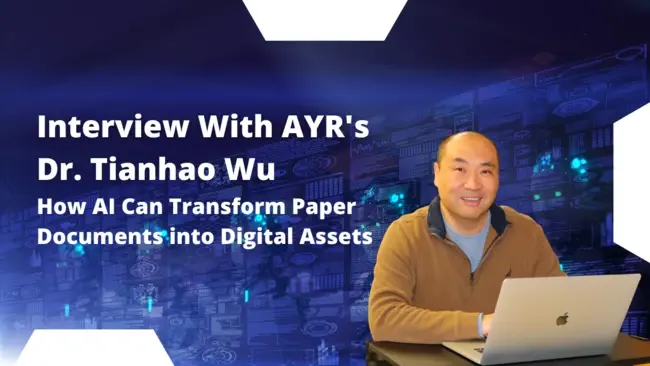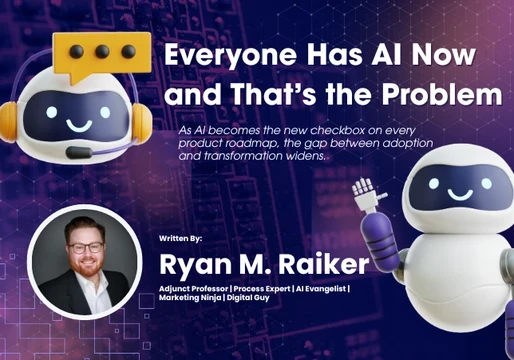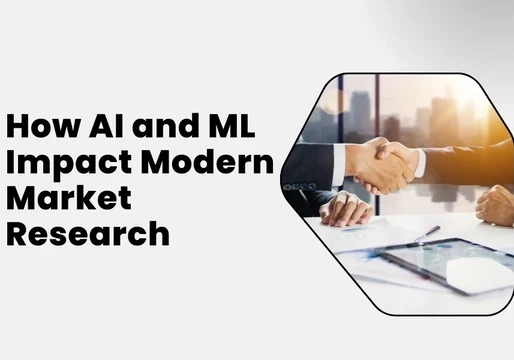In today's digital world, data is one of the most valuable assets for businesses. But paper documents still play a vital role in many industries, requiring manual processes and manual labor to process. This creates an opportunity for artificial intelligence (AI) to transform paper documents into digital data that can improve workflows and streamline operations. In this article, we'll explore how one data scientist and his latest start-up focused on building advanced AI tools can help make the process of turning paper-based documents into digital assets simpler and more efficient.
I recently had the opportunity to sit down with Dr. Tianhao Wu, who is a renowned software engineer and entrepreneur. Tianhao previously served as the director of data science at Workfusion, an AI-driven automation platform. He has filed several patents for AI and machine learning. Today, he is the CTO and co-founder of AYR, formerly named Singularity Systems, a startup focused on building an AI-powered platform to help businesses become more efficient and competitive.
At Workfusion, Dr. Wu led the development of their artificial intelligence (AI)-driven automation platform for enterprise customers, which helped them achieve tremendous cost savings and improved operational efficiency. His expertise in machine learning algorithms has been instrumental in helping Workfusion, and now AYR develop groundbreaking software solutions that automate mundane tasks while increasing accuracy and speed.
Dr. Wu is passionate about pushing boundaries regarding AI technology and ensuring it positively impacts our lives. He believes these technologies provide us with an opportunity not just to increase our productivity but also to improve our quality of life in the short and long term.

Thank you so much for joining us in this interview series! Before we dig in, our readers would like to get to know you. Can you tell us about your background?
I attended the prestigious Peking University, where I graduated in the top 5% of my class. I had long had aspirations to live the American dream, build software, and lead an amazing technology company.
After college, I worked as a software developer, and I attended Lehigh University at night. I earned my doctorate and continued on the path to one day be a leader in the technology and start-up. I spent time at Ask.com as their principal software engineer where I developed machine learning, natural language processing, classification, search engine user log analysis, and online ranking algorithms. I led a team to develop a search engine to provide direct answers for user queries. While it was all so fascinating, I still wanted to change the world of work for people. I later joined Workfusion where my development skills had a direct impact on the lives of regular business users.
How are organizations able to improve workflows and make work simple today?
According to Gartner, 91% of organizations are engaged in digital initiatives, and 87% of senior business leaders say digitalization is a priority.
The future of work will be highly automated, and for business leaders responsible for driving digital transformation, success will depend on getting the right tools or a combination of tools for the job. They must also deliver innovation that enables them to disrupt their industry without disrupting its day-to-day operations.
When it comes to improving workflow and making work simple I can;’t help but consider the mass amounts of digital transformation initiatives happening in businesses everywhere. With the buzz around Chat-GPT and other AI tools, there’s no denying that artificial intelligence (AI) is the way of the future. AI has been used for years to help with everything from automation to data analysis, but now it can be used for something new: transforming paper documents into digital assets. With AI, businesses can easily and quickly convert their physical documents into digital assets, streamlining workflows and making work much simpler.
Today, there are lots of tools to choose from, but I believe the next generation of intelligent document processing has the potential to make a major impact on the enterprise.
Why is automation of paper-based documents important for the future of work?
Automation of paper-based documents is important for the future of work because it offers an effective and efficient way to manage vital information. Automation eliminates manual data entry, reduces errors, reduces processing times, and improves accuracy. It also provides real-time visibility into organizational operations and streamlines document processes that can save time and money in the long run. Automation also helps to create a more organized workplace by allowing quick access to documents needed for decision-making, saving time and effort from searching physical files or spreadsheets. In addition, automated processes increase security by reducing the risk of data loss or theft. Automated processes help ensure data accuracy and protect against human error that can result in costly mistakes. Ultimately, automation of paper-based documents will help businesses enhance their productivity while keeping up with changing technologies in order to remain competitive in today's fast-paced business world.
How AI Can Transform Paper Documents to Digital Assets
AI has the potential to revolutionize document processing by transforming paper documents into digital assets quickly and accurately with minimal effort required on behalf of employees. AI-powered document recognition technology enables organizations to streamline their workflow by automatically extracting data from incoming paper documents and converting them into an easily readable digital format that can be stored in a secure repository for later retrieval. This technology can quickly recognize and classify documents based on their content, eliminating manual data entry and increasing accuracy. This allows for faster and simpler document processing, resulting in improved employee productivity. Additionally, AI-based document recognition offers enhanced security capabilities that protect confidential information and ensure compliance with regulations. With its ability to automate tedious tasks, reduce errors, improve security protocols, and provide detailed analytics reports - intelligent document processing makes it easier than ever for businesses to stay competitive in today's dynamic market landscape.
What are the benefits of AI-driven document conversion?
The advantages of using AI-driven document conversion are numerous. Not only does it save time and money by reducing the need for manual labor, but it also helps businesses streamline their processes by making it easier to find the information they need when they need it. Additionally, these tools can help ensure better accuracy in terms of information extraction since they can accurately read handwriting or detect typos that might otherwise be missed by human eyes. Finally, since these tools are automated, they don’t require any additional training once configured—saving businesses even more money in the long run.
Aren’t there already technologies that can transform paper documents into usable machine-readable text?
Many people think old approaches alone are good enough to get the job done. Technologies such as Optical Character Recognition (OCR) are especially useful for transforming paper documents into digital assets because they can quickly scan through large volumes of paperwork and accurately extract information from them in a fraction of the time it would take a person to do so manually. OCR also ensures that all data is accurately transcribed, eliminating potential errors due to human error or misreading of handwriting. Furthermore, OCR technology can be used to search through large databases of digital files quickly and efficiently, resulting in more organized workflows. At AYR, we built our very own proprietary OCR to do this, but we also paired it with advanced machine learning and natural language processing.
In addition to OCR, we use AI-driven technologies such as machine learning (ML) for digital transformation projects. ML algorithms can learn from data sets and adapt their performance over time without needing manual intervention or programming changes. This makes them more accurate over time as they process more documents and gain insight into patterns within the data sets they analyze. With ML algorithms powering document processing projects, organizations can get more precise results faster than ever before – leading to improved productivity across all departments involved in document processing workflows.
The potential applications of artificial intelligence (AI) in document digitization are limitless; not only does it make workflows more efficient by automating tedious manual processes, but it also helps ensure accuracy by detecting subtle changes in text or images that could otherwise go unnoticed by human eyes. Furthermore, storing all information digitally allows you to keep it secure while providing convenient accessibility across multiple devices with just a few clicks of a button. As businesses continue to look for ways to streamline their operations and make work simpler than ever before, there’s no doubt that AI will play an increasingly important role in transforming paper documents into digital assets moving forward.







Comments ( 0 )